
Berberis, commonly known as barberry, is a large genus of deciduous and evergreen shrubs from 1–5 m (3.3–16.4 ft) tall, found throughout temperate and subtropical regions of the world. Species diversity is greatest in South America and Asia; Europe, Africa and North America have native species as well. The best-known Berberis species is the European barberry, Berberis vulgaris, which is common in Europe, North Africa, the Middle East, and central Asia, and has been widely introduced in North America. Many of the species have spines on the shoots and all along the margins of the leaves.
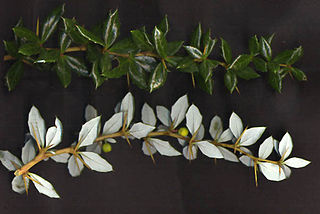
Berberis verruculosa, the warty barberry or warted barberry, is an evergreen shrub, ranging in size from 1–2 m, native to western China. It gets its common name from its "warty" stems, that have rounded, more or less identical, raised spots.

Berberis darwinii, Darwin’s barberry, is a species of flowering plant in the family Berberidaceae, native to southern Chile and Argentina and naturalized elsewhere. Vernacular names include michay, calafate, and quelung. Growing to 3–4 m (9.8–13.1 ft) tall, it is an evergreen thorny shrub.

Berberis vulgaris, also known as common barberry, European barberry or simply barberry, is a shrub in the genus Berberis. It produces edible but sharply acidic berries, which people in many countries eat as a tart and refreshing fruit.
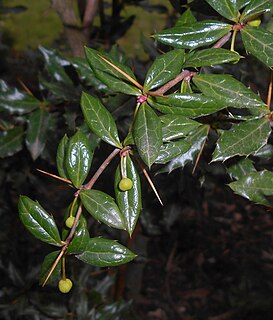
Berberis candidula is a species of plant in the family Berberidaceae. It is endemic to China, native to the provinces of Hubei and Sichuan.
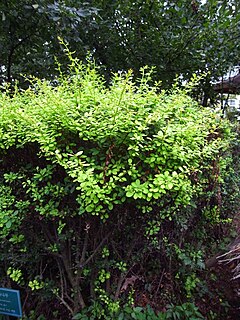
Berberis koreana, the Korean barberry, is deciduous shrub that can grow up to 5 feet (1.5 m) in height. The species is endemic to Korea. It is widely planted as an ornamental tree in North America, South America and Europe.
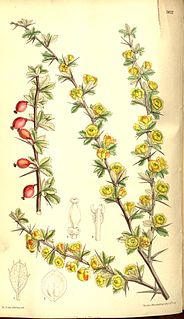
Berberis dictyophylla, the netleaf barberry, is a deciduous shrub in the genus Berberis which is native to Western China.
Berberis aemulans is a shrub endemic to the region of Sichuan in southern China. It grows there in thickets and on slopes at elevations of 2900–3200 m.

Berberis veitchii is a shrub native to western Hubei, China. It was once cultivated as an ornamental in other countries, the source almost certainly being seed collected by Wilson..

Berberis haematocarpa, Woot. with the common names red barberry, red Mexican barbery, Colorado barberry and Mexican barberry, is a species in the Barberry family in southwestern North America. It is also sometimes called algerita, but that name is more often applied to its relative, Mahonia trifoliolata.

Berberis julianae, the wintergreen barberry or Chinese barberry, is a flowering evergreen shrub native to Central China. It is widely grown as an ornamental in other temperate regions. It is reportedly naturalized in scattered parts of the United States.

Berberis aggregata, the clustered barberry, is a shrub native to western China. It grows at elevations of 1000–3500 m.
Berberis agricola is a plant species endemic to Xizang (Tibet). It grows on mountain slopes at elevations of 3200–3600 m.
Berberis amabilis is a shrub native to Yunnan and Myanmar (Burma). It grows at elevations of 1800–3300 m.
Berberis amoena is a shrub native to the Sichuan and Yunnan provinces of China. It is found at elevations of 1600–3100 m.

Berberis amurensis, commonly known as Amur barberry, is a shrub native to Japan, Korea, the Russian Far East, and parts of China. It is named for the Amur River, which forms part of the boundary between Russia and China. It is found at elevations of 1100–2900 m.
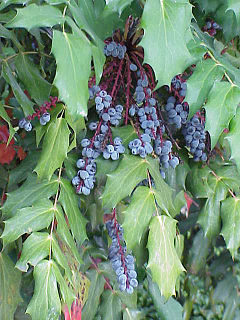
Berberis bealei, also known as leatherleaf mahonia, Beale's barberry, or Oregon grape, is a species of evergreen shrub native to mainland China. The species has been regarded as the same species as Berberis japonica, native to Taiwan, but the two differ consistently in certain floral and leaf characters. Both species are widely cultivated in many countries as ornamentals. Berberis bealei has reportedly escaped cultivation and become established in the wild in scattered places in the south-eastern United States from Arkansas to Florida to Delaware.
Berberis sikkimensis is a plant species native to the high Himalayas at elevations of 2000–3000 m. It is known from Sikkim, Nepal, Bhutan, Tibet and Yunnan.

Berberis laurina is a spiny and woody, (semi-)evergreen shrub belonging to the barberries in the family Berberidaceae. It may grow to up to 2½ m high. The leaves are bluish green, and may turn yellow or red during autumn and winter. It has drooping racemes of light yellow flowers. The species is endemic to Uruguay, southern Brazil and Argentina. The local name in Uruguay is espina amarilla, while it is called espinho-de-judeu in Brasil.
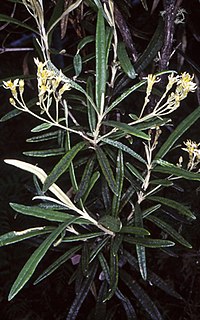
Olearia alpicola, commonly known as alpine daisy bush, is a shrub in the family Asteraceae and is found in mountainous terrain in New South Wales and Victoria in Australia. A small shrub with spreading branches and white daisy-like flowers.













